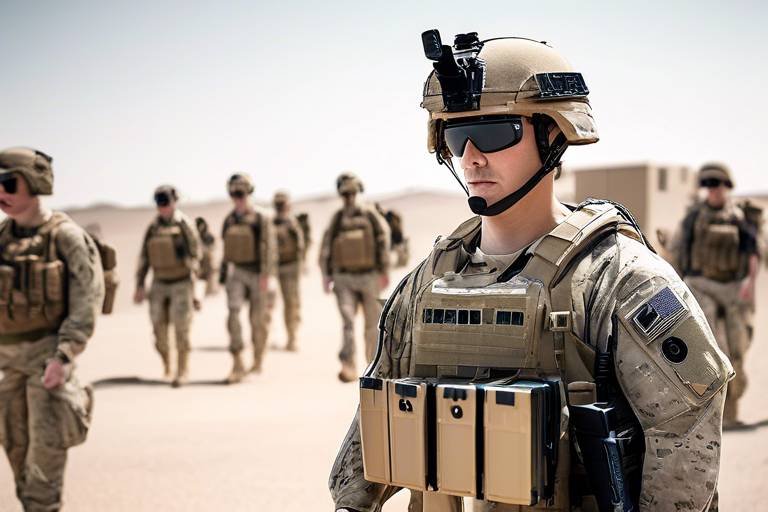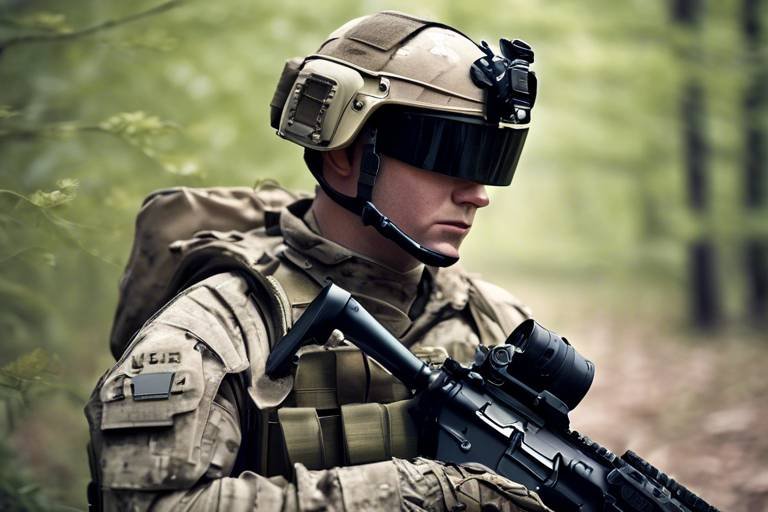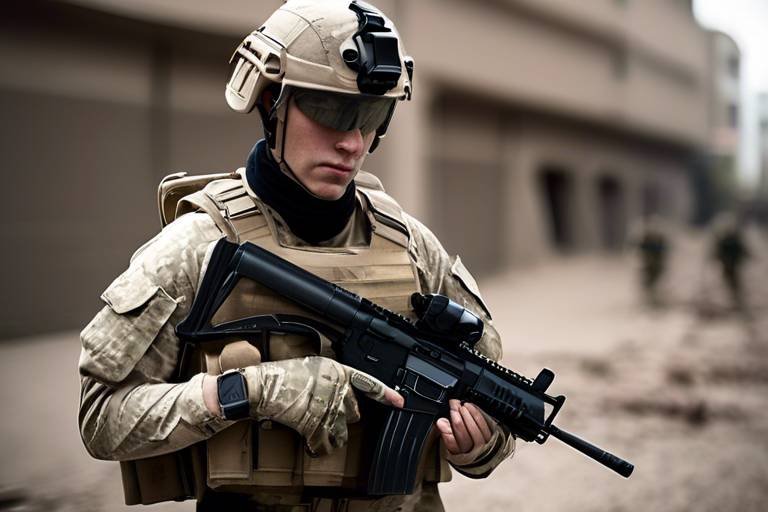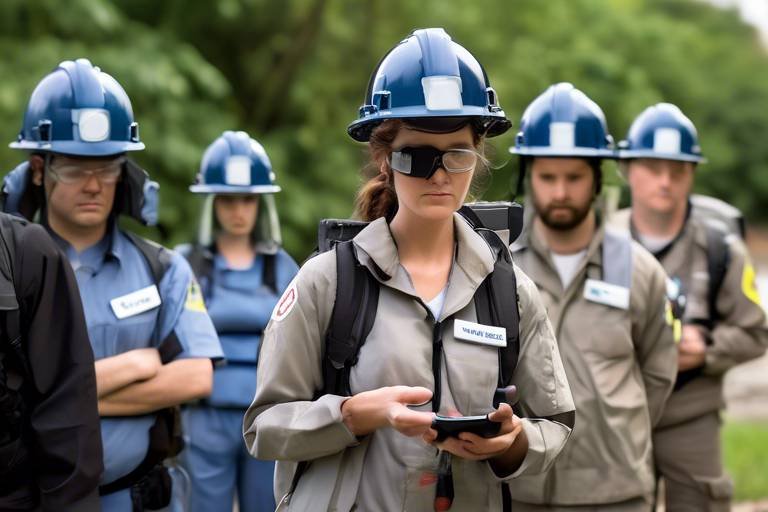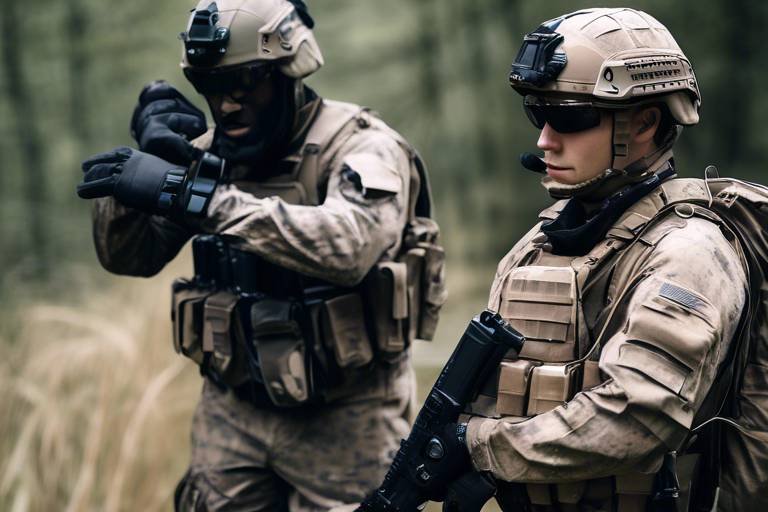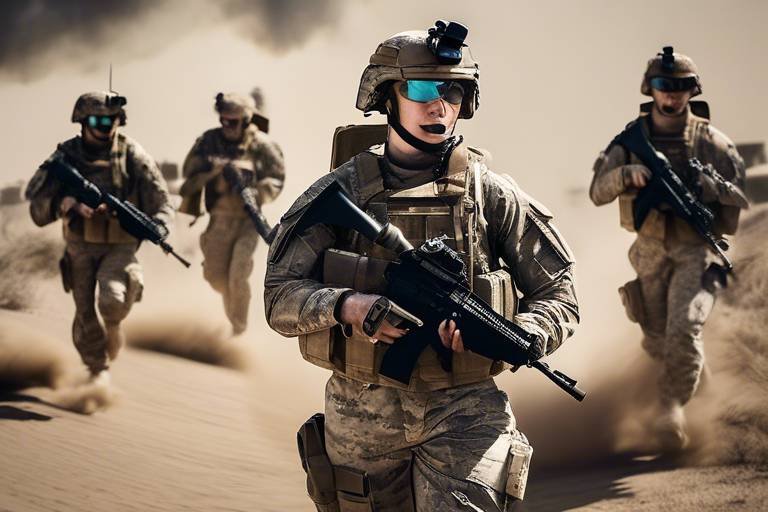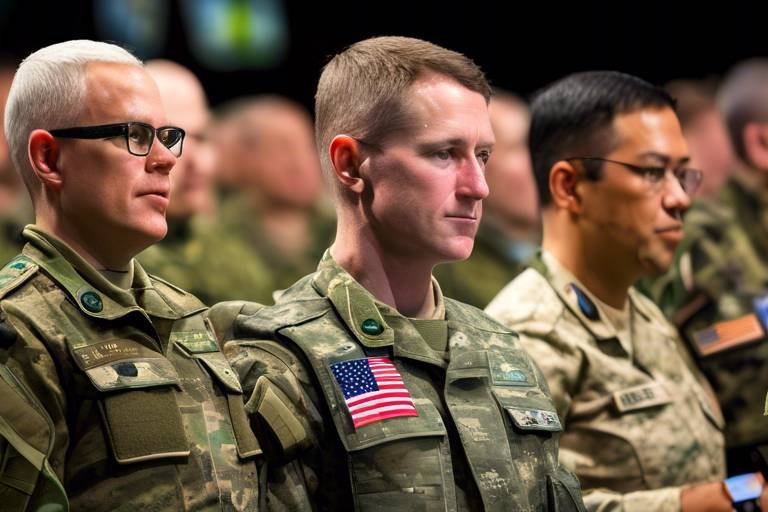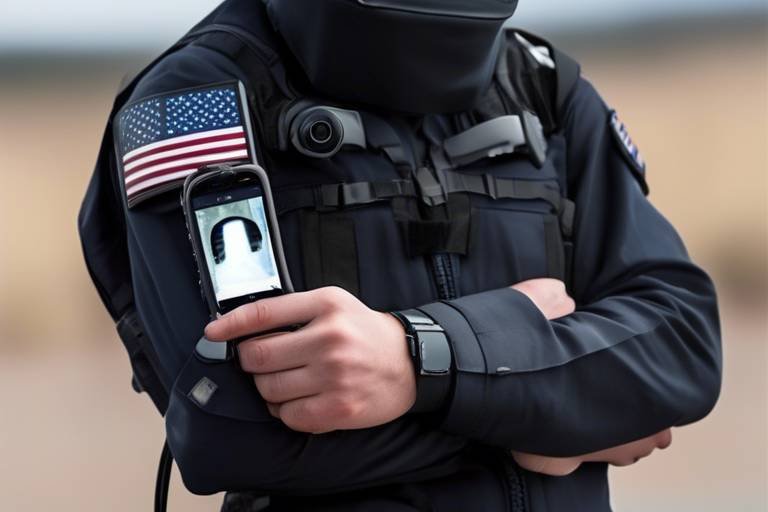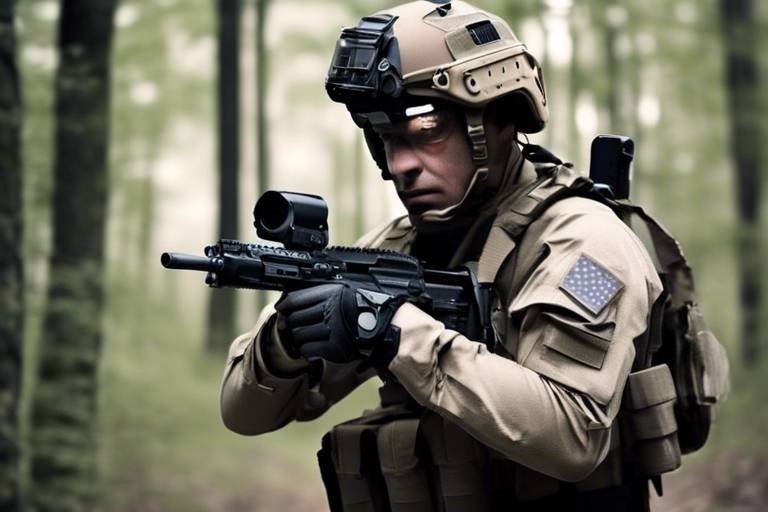The Impact of Wearables on Military Command and Control
In an era where technology is reshaping every aspect of our lives, the military is no exception. Wearable technology is making waves in military operations, revolutionizing how command and control functions on the battlefield. Imagine soldiers equipped with devices that not only monitor their health but also provide real-time data to commanders, enhancing situational awareness and decision-making. This article explores how wearable technology is transforming military operations, enhancing command and control capabilities, and improving situational awareness for personnel in the field.
Wearable devices are game-changers when it comes to situational awareness. They provide real-time data and analytics, allowing military personnel to make informed decisions quickly. Picture a soldier in the heat of battle, receiving instant updates about enemy movements or changes in the environment. This immediate access to information can mean the difference between success and failure. With wearables, data such as location, health metrics, and environmental conditions are constantly monitored and relayed to command centers, creating a comprehensive battlefield picture.
For instance, consider a scenario where a unit is ambushed. Wearables can alert nearby troops of the situation, share vital information about troop positions, and even provide medical data about injured soldiers. This level of connectivity and information flow enhances the ability to respond swiftly and effectively, ultimately saving lives and resources.
Communication is the backbone of military operations, and wearables facilitate seamless communication among troops and command centers. Imagine a network of soldiers, all equipped with devices that allow them to communicate instantly with one another, regardless of their location on the battlefield. This technology enhances operational efficiency and coordination, ensuring that everyone is on the same page.
Understanding how wearables can be integrated with current military systems is crucial. The compatibility of wearable technology with existing military infrastructure allows for a smoother transition and maximizes the benefits of these devices. For example, integrating wearables with existing communication systems can provide a unified platform for data sharing and decision-making.
Despite the benefits, integrating wearables poses challenges. Issues such as interoperability, data overload, and the need for robust training programs can hinder effective implementation. Additionally, ensuring that these devices are durable and reliable in harsh environments is paramount. However, by addressing these challenges head-on, the military can harness the full potential of wearable technology.
Real-world examples showcase successful integration of wearables in military operations. For instance, during a recent training exercise, a unit utilized smart helmets that provided augmented reality displays, enhancing situational awareness and tactical decision-making. These case studies illustrate the benefits and lessons learned, paving the way for broader adoption of wearable technology in military contexts.
As wearables collect sensitive data, ensuring security is paramount. The potential for breaches or misuse of information raises significant privacy concerns. Military operations must implement stringent measures to protect this data, including encryption and secure data transmission protocols. Addressing these concerns is essential for maintaining trust among personnel and ensuring the effectiveness of wearable technologies.
Wearable technology is revolutionizing military training programs. By incorporating wearables into training simulations, the military can create more realistic and immersive experiences for personnel. Imagine soldiers training in a virtual environment while their physiological data is being monitored in real-time. This data can provide insights into performance, allowing for targeted improvements and better preparedness for real-world scenarios.
Wearables allow for the monitoring of soldiers' physiological data during training. This real-time feedback can optimize training outcomes and readiness. For example, if a soldier is struggling with endurance, trainers can adjust their regimen based on the data collected from wearables, ensuring that each individual receives the support they need to excel.
The use of wearables creates adaptive learning environments for military personnel. By analyzing performance metrics, training programs can be personalized to fit the unique needs of each soldier. This tailored approach not only enhances individual performance but also strengthens the overall effectiveness of military units.
Looking ahead, emerging trends in wearable technology hold exciting potential for military command and control. As advancements in AI and machine learning continue to evolve, the integration of these technologies into wearables could significantly enhance decision-making capabilities. Imagine wearables that not only collect data but also analyze it in real-time, providing actionable insights to commanders on the ground.
The integration of AI into wearables promises to enhance decision-making. By analyzing data collected from wearables, AI can identify patterns and trends that may not be immediately obvious to human operators. This capability could lead to more informed strategic decisions and improved operational outcomes.
The future of wearables may include integration with autonomous systems. As drones and robots become more prevalent in military operations, wearables could serve as a bridge between human operators and these autonomous systems. This collaboration could enhance situational awareness and operational efficiency, creating a more cohesive and responsive military force.
- What are wearable technologies in the military? Wearable technologies are devices that can be worn on the body, such as smart helmets, health monitors, and communication devices, designed to enhance military operations.
- How do wearables improve situational awareness? Wearables provide real-time data and analytics, helping military personnel make informed decisions quickly, thereby enhancing situational awareness.
- What challenges do wearables face in military integration? Challenges include interoperability with existing systems, data security concerns, and ensuring the durability of devices in harsh environments.
- How are wearables used in military training? Wearables monitor physiological data during training, providing real-time feedback to optimize performance and create adaptive learning environments.
Enhanced Situational Awareness
In the fast-paced and often chaotic environment of military operations, having a clear and comprehensive understanding of the battlefield is crucial. This is where wearable technology shines, providing troops with real-time data and analytics that can significantly enhance their situational awareness. Imagine being in a high-stakes situation where every second counts; the ability to access critical information at a moment's notice can mean the difference between success and failure. Wearables, such as smart helmets and tactical vests equipped with sensors, are not just cool gadgets; they are lifelines that empower military personnel to make informed decisions quickly.
These devices collect a wealth of information, from location tracking to environmental conditions, and relay it back to command centers and individual soldiers. For instance, a soldier wearing a smart helmet can receive updates about enemy positions, weather changes, and even the status of fellow team members, all without taking their eyes off the mission at hand. This seamless flow of information helps create a shared understanding of the operational landscape, enabling teams to coordinate their actions more effectively.
Moreover, the integration of augmented reality (AR) into wearables takes situational awareness to another level. Picture this: a soldier looks through an AR visor and sees real-time data overlays on their field of vision, highlighting potential threats and allies. This immersive experience not only enhances decision-making but also reduces cognitive load, allowing soldiers to focus on executing their missions rather than sifting through information manually.
To illustrate the impact of wearables on situational awareness, consider the following table that summarizes key features and benefits:
| Feature | Benefit |
|---|---|
| Real-Time Data Access | Enables quick decision-making and response |
| Location Tracking | Improves coordination and reduces friendly fire incidents |
| Environmental Monitoring | Helps assess risks and adapt strategies accordingly |
| Augmented Reality Integration | Enhances situational awareness through visual data overlays |
In conclusion, the advent of wearable technology in military operations is a game-changer. By providing soldiers with enhanced situational awareness, these devices ensure that they are better equipped to face the unpredictable nature of the battlefield. As we continue to innovate and refine these technologies, the potential for improved outcomes in military engagements becomes increasingly promising.
Improved Communication Systems
In the fast-paced world of military operations, the ability to communicate effectively can mean the difference between success and failure on the battlefield. Wearable technology is revolutionizing how troops interact with one another and with command centers, paving the way for enhanced operational efficiency. Imagine a scenario where soldiers, equipped with advanced wearables, can share vital information in real-time, ensuring that everyone is on the same page. This seamless communication is not just a luxury; it is a necessity in modern warfare.
Wearable devices, such as smart helmets and tactical vests, are designed to facilitate instant communication among military personnel. These devices can integrate voice communication, text messaging, and data sharing into a single platform, allowing for a more coordinated response to emerging threats. For instance, a soldier on the ground can send a live feed of their surroundings back to command, enabling decision-makers to assess the situation and respond accordingly. This level of connectivity is akin to having a tactical advantage, where information flows like a well-oiled machine.
Moreover, the integration of wearables with existing communication systems enhances their effectiveness. Many military operations already rely on complex communication networks, and wearables can complement these systems by providing additional layers of data. For example, the Joint Tactical Radio System (JTRS) can work alongside wearable devices to ensure that voice and data communications are not only reliable but also secure. The combination of these technologies creates a robust communication framework that can withstand the rigors of combat.
| Wearable Device | Communication Feature | Benefits |
|---|---|---|
| Smart Helmet | Integrated communication system | Hands-free operation, real-time data sharing |
| Tactical Vest | Text and voice messaging | Quick updates, improved coordination |
| Body-Worn Sensors | Health monitoring and alerts | Immediate medical assistance, enhanced safety |
However, while the benefits of improved communication systems through wearables are clear, there are challenges that must be addressed. One of the primary concerns is the interoperability of different systems. Military units often use various communication technologies, and ensuring that wearables can effectively communicate with these systems is crucial. Additionally, the potential for technical failures in high-stress environments raises questions about reliability. To mitigate these risks, military planners are focusing on rigorous testing and training to ensure that personnel can effectively use these devices under pressure.
In conclusion, the integration of wearable technology into military communication systems is a game-changer. By facilitating real-time communication and enhancing situational awareness, wearables are setting a new standard for operational efficiency. As we look to the future, it is clear that these advancements will play a pivotal role in shaping how military forces operate, ensuring that they remain one step ahead in the ever-evolving landscape of warfare.
Integration with Existing Systems
When it comes to the battlefield, the integration of wearable technology with existing military systems is not just a luxury—it's a necessity. Imagine a world where soldiers can seamlessly access critical data and communicate effectively without the burden of cumbersome equipment. This is the promise of wearable tech, but achieving this integration is a complex task that requires careful planning and execution.
One of the primary challenges lies in ensuring that new wearable devices can communicate with legacy systems. Many military operations rely on established technologies that have been in use for years. These systems may not be designed to accommodate the rapid advancements in wearable tech. Therefore, military leaders must consider compatibility issues. For instance, if a soldier's wearable device collects real-time health metrics, it should be able to relay that information to command centers without delays or data loss.
Moreover, the integration process involves not only technical compatibility but also the need for training personnel to use these new technologies effectively. Soldiers must be familiar with how to operate their wearables, interpret the data they receive, and understand how it fits into the larger operational picture. This requires comprehensive training programs that focus on both the technical and practical aspects of using wearables in the field.
To illustrate the potential for integration, let’s look at a few key areas where wearables can enhance existing systems:
- Real-Time Data Sharing: Wearables can provide live updates to command centers, allowing for quicker decision-making.
- Health Monitoring: Integration with medical systems can ensure that vital signs are monitored and acted upon immediately.
- GPS and Navigation: Wearables can enhance navigation capabilities, offering real-time location data that is crucial for mission success.
Despite these opportunities, the integration of wearable technology into existing military frameworks is not without its hurdles. Issues such as data interoperability, where different systems may not speak the same "language," can hinder effective communication. Furthermore, the potential for increased cyber vulnerabilities must be addressed to protect sensitive military information.
In conclusion, while the integration of wearables with existing military systems presents challenges, the potential benefits are enormous. With proper planning, training, and a focus on cybersecurity, military organizations can leverage wearable technology to enhance their operational capabilities significantly. The future of military command and control could very well depend on how effectively these systems are integrated into the fabric of military operations.
Challenges of Integration
Integrating wearable technology into military operations is not without its challenges. While the potential benefits are immense, the path to seamless integration often resembles navigating a minefield. One of the primary hurdles is the compatibility of wearables with existing military systems. Many military infrastructures have been in place for years, and retrofitting these systems to accommodate new technology can be both costly and time-consuming.
Moreover, the interoperability between different types of wearable devices poses a significant challenge. Different branches of the military may use various systems and devices, leading to potential communication breakdowns. Imagine a situation where a soldier's wearable device cannot communicate vital data to command due to incompatibility issues. This could jeopardize mission success and, ultimately, lives.
Another critical challenge is the training required for personnel to effectively use these new technologies. Soldiers must not only learn how to operate the devices but also understand how to interpret the data they provide. This necessitates a comprehensive training program that can be resource-intensive and time-consuming. The military must ensure that all personnel are adequately trained, which can be a daunting task given the fast-paced nature of military operations.
Furthermore, there are security concerns associated with the use of wearable technology. As these devices collect sensitive data, they become potential targets for cyberattacks. Protecting this information is paramount, and military leaders must invest in robust cybersecurity measures to safeguard against breaches. This adds another layer of complexity to the integration process.
In summary, while the integration of wearable technology into military operations holds great promise, it is accompanied by significant challenges that must be addressed. From compatibility and interoperability issues to the need for extensive training and robust security measures, the path to successful integration is fraught with obstacles. However, with careful planning and investment, these challenges can be overcome, paving the way for a new era of military operations.
- What are wearables in a military context? Wearables refer to smart devices that can be worn on the body, such as smartwatches or fitness trackers, which collect and analyze data to enhance military operations.
- How do wearables improve situational awareness? Wearables provide real-time data and analytics, allowing military personnel to make informed decisions quickly and effectively.
- What are the main challenges of integrating wearables? Key challenges include compatibility with existing systems, interoperability among devices, the need for extensive training, and security concerns regarding data protection.
- Can wearables be used for training purposes? Yes, wearables can monitor physiological data during training, providing real-time feedback to optimize performance and readiness.
- What future trends are expected in wearable technology for the military? Future trends may include advancements in AI integration and the potential for wearables to work alongside autonomous systems like drones and robots.
Case Studies of Successful Integration
When it comes to the integration of wearable technology in military operations, several case studies stand out, showcasing the transformative effects of these devices in real-world scenarios. One notable example is the use of smart helmets by the U.S. Army. These helmets are equipped with augmented reality (AR) displays that provide soldiers with critical information directly in their line of sight. Imagine a soldier on the battlefield receiving real-time data about enemy positions and terrain features without needing to consult a map or a handheld device. This not only enhances their situational awareness but also allows for quicker decision-making, potentially saving lives.
Another impressive case is the implementation of wearable sensors by the British Army during joint exercises with NATO forces. These sensors monitor soldiers' physiological data, such as heart rate and body temperature, providing commanders with insights into the physical condition of their troops. This real-time health monitoring is crucial in high-stress environments, enabling command centers to make informed decisions about troop deployment and safety. For instance, during a recent exercise, commanders were able to identify fatigue levels among troops and adjust the training regimen accordingly, ensuring that soldiers remained at peak performance.
Furthermore, the integration of wearable technology has also been evident in the Israeli Defense Forces (IDF), where soldiers use GPS-enabled wristbands during training exercises. These wristbands track each soldier's location and movements, allowing for comprehensive analysis post-exercise. The data collected helps in assessing individual performance and can be used to tailor future training programs. This level of data-driven analysis not only enhances training outcomes but also fosters a culture of continuous improvement within the military.
To provide a clearer picture, here’s a summary of some of these successful integrations:
| Case Study | Technology Used | Benefits |
|---|---|---|
| U.S. Army Smart Helmets | Augmented Reality Displays | Enhanced situational awareness and quicker decision-making. |
| British Army Wearable Sensors | Physiological Monitoring Sensors | Real-time health monitoring for informed troop management. |
| Israeli Defense Forces GPS Wristbands | GPS Tracking Technology | Data-driven performance analysis for tailored training. |
These case studies illustrate the profound impact that wearable technology can have on military operations. By improving situational awareness, enhancing communication, and providing valuable data analytics, wearables are not just a trend; they represent a significant leap forward in how military forces operate. As these technologies continue to evolve, we can expect even more innovative applications that will further enhance the effectiveness and safety of military personnel in the field.
- What are wearables in the military context? Wearables refer to technology devices that can be worn on the body, such as smart helmets, sensors, and GPS devices, designed to enhance operational efficiency and situational awareness.
- How do wearables improve situational awareness? Wearables provide real-time data and analytics, allowing military personnel to access critical information instantly, which aids in faster decision-making.
- Are there any privacy concerns with military wearables? Yes, as wearables collect sensitive data, there are significant privacy and security concerns that must be addressed to protect personnel information.
- What is the future of wearable technology in the military? The future of wearables in the military looks promising, with advancements in AI and machine learning expected to enhance their capabilities further.
Data Security and Privacy Concerns
As the military increasingly adopts wearable technology, the issue of data security and privacy becomes paramount. Wearable devices, such as smart helmets and body sensors, are designed to collect a wealth of information, including physiological data, location tracking, and even communication logs. This data can be invaluable for enhancing operations and ensuring the safety of personnel. However, it also presents significant risks if not properly secured. Imagine a situation where sensitive troop movements or health data fall into the wrong hands; the consequences could be disastrous.
To mitigate these risks, military organizations must implement robust security protocols. This includes strong encryption methods, secure data transmission channels, and regular audits of data storage practices. Furthermore, personnel should be trained on the importance of data security, ensuring they understand how to use these devices safely and effectively. For example, soldiers should be aware of potential phishing attacks that could compromise their devices and the sensitive information they hold.
In addition to technical measures, there are ethical considerations regarding privacy. Military personnel may feel uncomfortable knowing that their every move and biometric data is being tracked. It is crucial to strike a balance between operational efficiency and the rights of individuals. Establishing clear guidelines on data usage, access, and retention can help build trust among personnel. Transparency about how data is collected and used is essential; soldiers should know who has access to their information and for what purposes.
Moreover, the potential for data breaches is an ever-present threat. Cybersecurity experts warn that as wearable technology becomes more integrated into military operations, the attack surface for cybercriminals expands. Therefore, it's vital to continuously update software and security measures to combat emerging threats. The military must adopt a proactive approach to cybersecurity, akin to a game of chess where anticipating the opponent's move is crucial for success.
To summarize, while wearable technology offers numerous benefits to military operations, it also brings significant data security and privacy concerns that must be addressed. By implementing strong security measures, fostering a culture of awareness, and ensuring ethical data handling practices, the military can harness the power of wearables while protecting the privacy and security of its personnel.
- What types of data do military wearables collect?
Military wearables can collect various types of data, including physiological metrics (heart rate, body temperature), location information, and communication logs. - How is the data from wearables secured?
Data security is ensured through strong encryption, secure transmission channels, and regular audits of data storage practices. - What are the privacy concerns associated with military wearables?
Privacy concerns include the potential misuse of sensitive data and the discomfort personnel may feel knowing they are being constantly monitored. - How can the military build trust regarding data usage?
Establishing clear guidelines on data access and retention, along with transparency about data collection methods, can help build trust among personnel.
Impact on Training and Simulation
Wearable technology is not just a buzzword; it's a game-changer for military training programs. Imagine soldiers gearing up with devices that not only track their movements but also offer insights into their physiological state in real-time. This innovative approach transforms traditional training into a more engaging and effective experience. With wearables, military personnel can receive immediate feedback on their performance, allowing them to adjust their tactics and techniques on the fly. This kind of instant data can be the difference between success and failure in high-stakes situations.
One of the most exciting aspects of wearables in training is their ability to create real-time performance monitoring. For instance, a soldier wearing a biometric monitor can have their heart rate, oxygen levels, and stress indicators tracked continuously. In a training exercise, if a soldier's heart rate spikes, instructors can step in to assess whether they are pushing too hard or if they need to adjust their approach. This level of monitoring not only enhances individual performance but also contributes to overall unit readiness.
Moreover, wearables facilitate the development of adaptive learning environments. Each soldier is unique, and their training should reflect that. With wearables, data collected can be analyzed to personalize training experiences based on individual performance metrics. For example, if a particular soldier struggles with marksmanship, their training regimen can be adjusted to include more targeted exercises. This personalized approach ensures that each service member is not just trained uniformly but is equipped to excel in their specific roles.
Additionally, the integration of wearables into training simulations adds a layer of realism that traditional methods simply cannot match. Imagine a training scenario where soldiers are equipped with augmented reality headsets that overlay critical information about their environment. This technology allows them to practice tactics in a simulated battlefield while receiving real-time data from their wearables. Such immersive experiences prepare soldiers for the unpredictable nature of real combat.
However, the implementation of wearables in training is not without its challenges. Issues such as data overload can occur, where the sheer volume of information becomes overwhelming. To combat this, training programs must prioritize what data is essential and how it is presented to the trainees. Furthermore, ensuring that all personnel are adequately trained to use these devices effectively is crucial for maximizing their benefits.
In conclusion, the impact of wearable technology on military training and simulation is profound. By enabling real-time performance monitoring and fostering adaptive learning environments, wearables are revolutionizing how soldiers are prepared for combat. As technology continues to evolve, the potential for even more advanced applications in training is limitless, promising a future where military personnel are better equipped, more informed, and ultimately more effective in their roles.
- What types of wearable technology are used in military training? Wearable technology can include biometric monitors, augmented reality headsets, and GPS tracking devices, among others.
- How does real-time performance monitoring improve training outcomes? It allows for immediate feedback, enabling soldiers to adapt their performance and techniques during training exercises.
- Can wearables be integrated with existing military training systems? Yes, many wearable devices are designed to be compatible with current military systems, enhancing their functionality.
- What are the challenges of implementing wearables in military training? Challenges include data overload, the need for proper training on device usage, and ensuring data security.
Real-Time Performance Monitoring
Imagine a battlefield where every soldier is equipped with cutting-edge wearable technology that not only tracks their movements but also monitors their physiological data in real-time. This is not a scene from a futuristic movie; it’s the reality of modern military training and operations. Wearable devices, such as smart helmets and biometric sensors, are revolutionizing how military personnel assess their performance and readiness. These devices collect vital data, including heart rate, body temperature, and fatigue levels, providing commanders with a comprehensive overview of a soldier's physical state at any given moment.
The significance of cannot be overstated. It allows military leaders to make informed decisions swiftly, ensuring that troops are operating at optimal levels. For instance, if a soldier's heart rate spikes during a training exercise, it could indicate overexertion or stress. Commanders can then intervene, providing immediate support or adjusting the training regimen to prevent injuries. By utilizing this technology, the military can enhance not only individual performance but also overall team effectiveness.
Furthermore, the data collected from wearables can be analyzed to identify patterns and trends over time. For example, a soldier who consistently shows signs of fatigue may benefit from a tailored training program that emphasizes recovery techniques. This personalized approach not only boosts performance but also enhances the overall well-being of military personnel. The ability to adapt training programs based on real-time data creates a more responsive and effective military force.
To illustrate the impact of real-time performance monitoring, consider the following table that outlines key benefits:
| Benefit | Description |
|---|---|
| Injury Prevention | By monitoring physiological data, potential injuries can be identified early, allowing for timely interventions. |
| Enhanced Readiness | Real-time feedback helps ensure that soldiers are physically and mentally prepared for missions. |
| Data-Driven Decisions | Commanders can make informed decisions based on accurate, up-to-date information about their troops. |
| Personalized Training | Training programs can be adjusted to meet the individual needs of soldiers, maximizing their performance potential. |
In addition to these benefits, real-time performance monitoring fosters a culture of accountability among soldiers. When individuals know that their performance is being tracked, they are more likely to push themselves and strive for improvement. This sense of responsibility can lead to enhanced teamwork and camaraderie, as soldiers work together to achieve common goals.
As the military continues to integrate wearable technology, the potential for real-time performance monitoring will only expand. Future advancements may include even more sophisticated sensors and analytics, offering deeper insights into soldier performance and health. The military is on the brink of a new era where data-driven strategies will not only enhance training and readiness but also ensure the safety and well-being of every service member.
- What types of wearable technology are used in the military?
Wearable technology in the military includes smart helmets, biometric sensors, and GPS tracking devices that monitor soldiers' health and location in real-time. - How does real-time performance monitoring improve soldier safety?
By tracking physiological data, commanders can identify signs of fatigue or stress, allowing for immediate intervention and reducing the risk of injury. - Can wearable technology be used in combat situations?
Yes, wearables can provide critical data in combat, enhancing situational awareness and decision-making for both soldiers and commanders. - What are the future trends in military wearables?
Future trends may include advanced AI integration, improved data analytics, and the potential for collaboration with autonomous systems.
Adaptive Learning Environments
In the fast-paced world of military training, the ability to adapt and evolve is crucial. Wearable technology is at the forefront of this evolution, creating that significantly enhance the training experience for military personnel. Imagine stepping into a training scenario where your performance data is not just collected but analyzed in real-time, allowing for immediate adjustments to your training regimen. This is the power of wearables, transforming traditional training into a highly personalized experience.
These devices monitor various physiological metrics such as heart rate, stress levels, and even fatigue, providing trainers with a comprehensive view of each soldier's condition. With this information, instructors can tailor training sessions to meet the specific needs of individuals or teams. For instance, if a soldier shows signs of excessive fatigue, the training program can be adjusted to focus on recovery and skill refinement rather than pushing through a potentially harmful workout. This level of personalization not only enhances the effectiveness of training but also helps in preventing injuries.
Furthermore, the integration of wearables fosters a culture of continuous improvement. Soldiers can receive instant feedback on their performance, allowing them to make real-time adjustments. This is akin to having a personal coach available at all times, guiding each individual to achieve their peak performance. The data collected can also be used to create detailed reports, enabling trainers to identify trends and areas for improvement across the entire unit.
Adaptive learning environments powered by wearables can also facilitate peer-to-peer learning. Soldiers can share insights and strategies based on their performance data, creating a collaborative learning atmosphere. For example, if one soldier excels in a particular skill, they can mentor others, using their data to demonstrate effective techniques. This not only builds camaraderie but also enhances overall unit performance.
As we look to the future, the potential of these adaptive environments is immense. With advancements in technology, we may see the incorporation of augmented reality (AR) and virtual reality (VR) into training programs, further enriching the learning experience. Imagine a scenario where soldiers can engage in realistic simulations that adapt to their performance in real-time, providing challenges that are neither too easy nor too difficult. This balance is key to maintaining engagement and ensuring effective learning.
In conclusion, the incorporation of wearable technology into military training is not just a trend; it represents a fundamental shift towards more personalized, effective, and adaptive learning environments. By leveraging data and technology, the military can ensure that its personnel are not only prepared for the challenges they will face but are also continually evolving to meet those challenges head-on.
- How do wearables improve military training?
Wearables provide real-time data on soldiers' physiological metrics, allowing for personalized training adjustments and immediate feedback on performance.
- What types of data do wearables collect?
They typically monitor heart rate, stress levels, fatigue, and other physiological indicators that are critical for optimizing training and performance.
- Can wearables be used in live combat situations?
Yes, wearables can enhance situational awareness and communication in combat, providing real-time data to soldiers and command centers.
- What is the future of wearable technology in the military?
The future may include advanced integrations with AI, AR, and VR, further enhancing training and operational capabilities.
Future Trends in Wearable Technology
The world of wearable technology is evolving at a breakneck speed, especially in military applications. As we look to the future, it’s clear that these advancements will not only enhance the capabilities of military personnel but also redefine the entire landscape of military operations. Imagine a battlefield where soldiers are equipped with devices that not only track their health but also provide real-time data analysis to inform tactical decisions. This is the future we are heading towards, and it’s nothing short of revolutionary.
One of the most exciting trends is the integration of artificial intelligence (AI) into wearable devices. This integration promises to enhance decision-making by allowing wearables to analyze vast amounts of data collected from various sources. For instance, AI can process physiological data, environmental conditions, and even operational metrics to provide insights that were previously unattainable. This means that commanders can receive actionable intelligence in real time, allowing for quicker and more informed decisions on the ground.
Moreover, the potential for autonomous systems to work alongside wearables is another trend that is gaining traction. Picture this: soldiers equipped with wearables that communicate seamlessly with drones or robotic units. These systems could work in tandem, with wearables providing situational updates that guide autonomous systems in real-time. This synergy could lead to more efficient mission execution and enhanced safety for personnel, as drones could scout ahead or provide support without putting soldiers in harm's way.
Furthermore, as wearables become more sophisticated, we can expect advancements in biometric monitoring. Future wearables might not only track heart rates and physical activity but could also assess mental states through physiological indicators. This could be crucial for identifying soldiers who are experiencing stress or fatigue, enabling commanders to intervene before these issues escalate. The ability to monitor both physical and mental health in real time could significantly improve overall troop readiness and effectiveness.
In addition to these technological advancements, we should also consider the implications of data security and privacy. As wearables collect sensitive information, ensuring that this data is protected will be paramount. Future technologies will likely incorporate advanced encryption methods and secure communication protocols to safeguard against potential breaches. Military organizations will need to stay ahead of the curve to protect their personnel and maintain operational integrity.
As we explore these future trends, it’s essential to remain cognizant of the challenges that lie ahead. Integration with existing military systems, ensuring interoperability, and addressing privacy concerns are just a few hurdles that must be navigated. However, the potential benefits far outweigh these challenges. The military's embrace of wearable technology is not just about keeping pace with innovation; it’s about enhancing operational effectiveness and ensuring the safety of personnel in increasingly complex environments.
- What are the main benefits of wearable technology in the military?
Wearable technology enhances situational awareness, improves communication, and allows for real-time monitoring of health and performance metrics. - How does AI enhance wearable technology?
AI analyzes data from wearables to provide actionable insights, improving decision-making and operational efficiency. - What are the privacy concerns associated with military wearables?
Wearables collect sensitive data, making data security and privacy paramount to protect personnel and operational integrity. - Will wearables be integrated with autonomous systems?
Yes, future trends indicate that wearables will work alongside drones and robots to enhance mission execution and safety.
AI Integration in Wearables
The integration of Artificial Intelligence (AI) into wearable technology is nothing short of revolutionary, especially in the context of military operations. Imagine a soldier on the battlefield equipped with a device that not only tracks their location but also analyzes their physiological data in real time. This is the future we are heading toward, where wearables equipped with AI can significantly enhance decision-making processes and operational efficiency.
AI-powered wearables can process vast amounts of data collected from various sensors, offering insights that were previously unattainable. For instance, consider a scenario where a soldier's heart rate, body temperature, and even stress levels are monitored continuously. The AI can analyze this data and provide immediate feedback, alerting the soldier to potential health risks or suggesting optimal strategies based on their current condition. This level of real-time analysis can be a game changer in high-stress environments, allowing personnel to make informed decisions quickly.
Moreover, AI integration can facilitate predictive analytics. By examining historical data and current trends, AI can forecast potential outcomes and suggest preemptive actions. For example, if a unit is moving into a high-risk area, the AI can analyze past encounters, terrain types, and enemy movements to recommend the safest routes or tactics. This predictive capability not only enhances safety but also increases the overall effectiveness of military operations.
To illustrate the potential of AI in wearables, let's look at a few key features:
- Real-time Data Processing: AI algorithms can analyze data on-the-fly, providing immediate insights that can influence tactical decisions.
- Adaptive Learning: Over time, AI systems can learn from the wearer's habits and preferences, tailoring recommendations and alerts to individual needs.
- Enhanced Communication: AI can assist in filtering and prioritizing communications, ensuring that critical information reaches the right personnel at the right time.
As we delve deeper into the world of wearable technology, the integration of AI presents exciting possibilities. However, it also raises questions about data security and privacy. With such sensitive information being processed, it is crucial to implement robust security measures to protect against potential breaches. The military must ensure that AI systems are not only effective but also secure, preserving the integrity of the data collected.
In conclusion, the fusion of AI with wearable technology holds the promise of transforming military operations. By enhancing situational awareness, improving decision-making, and providing real-time insights, AI-integrated wearables are set to redefine how military personnel operate in the field. As we continue to explore these advancements, it is essential to remain vigilant about the challenges they may present, particularly in terms of security and privacy.
Potential for Autonomous Systems
The future of military operations is not just about enhancing the capabilities of human soldiers; it's also about integrating autonomous systems that can work in tandem with wearable technology. Imagine a battlefield where soldiers are equipped with wearables that not only track their health and performance but also communicate seamlessly with drones and robotic systems. This synergy could revolutionize how military missions are executed, making them more efficient and less hazardous.
Wearable devices can serve as the central hub for data collection, relaying vital information to autonomous systems that can analyze the battlefield in real-time. For instance, if a soldier is in a high-risk area, their wearable could alert a nearby drone to provide aerial surveillance or even deliver supplies. This collaboration between human operators and autonomous systems can drastically improve situational awareness and response times, allowing for quicker decision-making in critical scenarios.
Furthermore, the integration of wearables with autonomous systems opens up a plethora of possibilities:
- Enhanced Surveillance: Drones equipped with cameras can receive real-time data from soldiers' wearables, enabling them to focus on high-priority areas.
- Logistics Support: Autonomous vehicles can transport supplies based on the needs communicated through wearables, ensuring that troops have what they need when they need it.
- Threat Detection: Wearables can monitor environmental conditions and soldier vitals, sending alerts to autonomous systems that can assess threats more effectively.
However, the path to fully integrating these technologies is not without its challenges. Issues such as data compatibility, security, and operational reliability must be addressed to ensure that these systems can work harmoniously. Moreover, ethical considerations regarding the use of autonomous systems in combat situations cannot be overlooked. Will these systems operate under the same rules of engagement as human soldiers? How do we ensure accountability?
As we look to the future, the potential for autonomous systems in military operations is immense. The combination of wearables and autonomous technology could lead to a new era of warfare where human soldiers are supported by intelligent machines, enhancing both effectiveness and safety. This not only changes the dynamics of combat but also raises important questions about the nature of warfare itself. How will these advancements shape the training of future soldiers? Will we see a shift in military strategies that prioritize technology over traditional tactics? Only time will tell, but one thing is certain: the integration of wearables with autonomous systems is a game-changer that could redefine military operations.
- What are wearable technologies in the military? Wearable technologies in the military refer to devices that soldiers can wear, such as smartwatches and health monitors, which provide real-time data for improved situational awareness and decision-making.
- How do wearables improve communication? Wearables enhance communication by allowing troops to send and receive information quickly and efficiently, ensuring that everyone is on the same page during operations.
- What challenges exist with integrating wearables into military systems? Challenges include data compatibility, security concerns, and the need for reliable performance in various environmental conditions.
- Can wearables work with autonomous systems? Yes, wearables can communicate with autonomous systems, allowing for enhanced surveillance, logistics support, and threat detection on the battlefield.
Frequently Asked Questions
- What are wearables in the military context?
Wearables in the military context refer to advanced technology devices that can be worn on the body, such as smart glasses, fitness trackers, and communication headsets. These devices collect and analyze data, providing real-time insights to enhance decision-making and situational awareness for military personnel.
- How do wearables enhance situational awareness on the battlefield?
Wearables enhance situational awareness by delivering real-time data and analytics directly to soldiers. This allows them to make informed decisions quickly, improving their ability to respond to dynamic situations and threats during operations.
- What challenges exist in integrating wearable technology into military operations?
Integrating wearable technology into military operations can present challenges such as compatibility with existing systems, data security concerns, and the need for extensive training on new devices. Overcoming these obstacles is essential for effective implementation.
- How does wearable technology improve communication among troops?
Wearable technology facilitates seamless communication among troops and command centers by providing efficient channels for information exchange. This enhances operational coordination and ensures that all personnel are on the same page, which is crucial for mission success.
- What role does data security play in the use of wearables?
Data security is paramount when using wearables in military contexts, as these devices often collect sensitive information. Measures such as encryption, secure data transmission, and strict access controls are necessary to protect this information from unauthorized access.
- How are wearables changing military training programs?
Wearables are revolutionizing military training by providing real-time performance monitoring and creating adaptive learning environments. This technology allows trainers to tailor programs based on individual performance metrics, leading to better preparedness and effectiveness in real-world scenarios.
- What future trends can we expect in military wearable technology?
Future trends in military wearable technology may include advancements in artificial intelligence and machine learning, which can enhance decision-making capabilities. Additionally, we may see greater integration with autonomous systems, such as drones and robots, to support military operations.
- Can wearables monitor soldiers' physiological data?
Yes, wearables can monitor various physiological data of soldiers, such as heart rate, temperature, and stress levels. This real-time feedback can optimize training outcomes and ensure that personnel are physically prepared for their missions.



